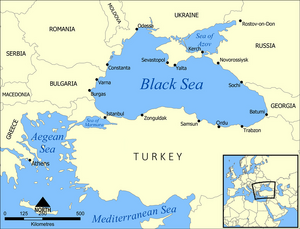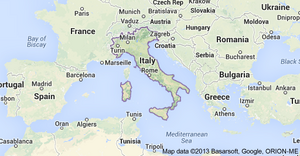Bulgaria



Bulgaria is a country located in Southeastern Europe.
Location
It is bordered by Romania to the north, Serbia and Macedonia to the west, Greece and Turkey to the south, and the Black Sea to the east.
Origin of name
- Bulgaria gets name after tribe Bulgar (Balhara) of Central Asia Turkic origin.
- According to Bhim Singh Dahiya, name of the country Bulgaria is after the Bal Jat clan. 'Bulgaria' means the land of the caravan (wagons) of the Balls. [1]
Population
History
Thracians, one of the three primary ancestral groups of modern Bulgarians,[2] began appearing in the region during the Iron Age.[3] Most of their numerous tribes were united in the Odrysian kingdom around 500 BC by king Teres,[4][5] but they were eventually subjugated by Alexander the Great and later by the Romans in 46 AD. After the division of the Roman Empire in 5th century the area fell under Byzantine control. By this time, Christianity had already spread in the area. A small Gothic community in Nicopolis ad Istrum produced the first Germanic language book in the 4th century, the Wulfila Bible.[6][7] The first Christian monastery in Europe was established around the same time by Saint Athanasius in central Bulgaria. From the 6th century the easternmost South Slavs gradually settled in the region, assimilating the Hellenised or Romanised Thracians.[8][9]
In the 7th century, Bulgar tribes (likely of Central Asian Turkic origin),[10] migrated to the lower courses of the rivers Danube, Dniester and Dniepr under the leadership of Asparukh. After 670 he moved into the Balkan Peninsula with a horde of 50,000 Bulgars across the Danube[11] and in 680 severed Scythia Minor from the Byzantine Empire.[12] A peace treaty with Byzantium in 681 and the establishment of a permanent capital at Pliska south of the Danube marked the beginning of the First Bulgarian Empire. The Bulgars gradually mixed up with the local population, adopting a common language on the basis of Slavonic.[13]
Succeeding khans strengthened the Bulgarian state throughout the 8th and 9th centuries—Tervel established Bulgaria as a major military power by defeating a 26,000-strong Arab army during the Second Arab Siege of Constantinople. Krum doubled the country's territory, killed Byzantine emperor Nicephorus I in the Battle of Pliska,[14] and introduced the first written code of law. In 864 Boris I abolished paganism in favour of Eastern Orthodox Christianity. Simeon the Great's 34-year rule began in 893 and saw the largest territorial expansion of Bulgaria, along with a golden age of Bulgarian culture.[15]
Wars with Croatians, Magyars, Pechenegs and Serbs and the spread of the Bogomil heresy weakened Bulgaria after Simeon's death. Two consecutive Rus' and Byzantine invasions resulted in the seizure of the capital Preslav by the Byzantine army in 971. Under Samuil, Bulgaria somewhat recovered from these attacks and managed to conquer Serbia and Albania,[16] but this rise ended when Byzantine emperor Basil II defeated the Bulgarian army at Klyuch in 1014. Samuil died shortly after the battle, and by 1018 the Byzantines had ended the First Bulgarian Empire.[17] =
17 interesting facts about Bulgaria
Here are 17 interesting facts you may not know about Bulgaria:
1. Oldest Gold Treasure: The world's oldest gold treasure was discovered in Bulgaria's Varna Necropolis, dating back to 4500 BC.
2. Home of Cyrillic Alphabet: Bulgaria is the birthplace of the Cyrillic alphabet, created in the 9th century by Saints Cyril and Methodius.
3. No Nod Means 'No': Bulgarians nod their heads for "no" and shake their heads for "yes," which can confuse visitors.
4. Land of Roses: Bulgaria is one of the largest producers of rose oil in the world, used in perfumes and cosmetics.
5. Rich History: Bulgaria is one of the oldest countries in Europe and has kept its original name since its founding in 681 AD.
6. Mountains and Nature: About 30% of Bulgaria is covered by mountains, making it a haven for hikers and skiers.
7. Unique Folklore: Bulgarian folk music features haunting melodies and rhythms, with UNESCO recognizing some traditions as intangible cultural heritage.
8. Thracian Legacy: The Thracians, an ancient civilization, left behind mysterious tombs and artifacts found throughout Bulgaria.
9. The Danube River: The Danube forms part of Bulgaria's northern border and is a vital natural resource.
10. Sunny Beach: Bulgaria's Black Sea coast is famous for its sunny beaches, attracting tourists from around the world.
11. Inventor of Yogurt: Bulgarian yogurt, made with Lactobacillus bulgaricus, is considered one of the best in the world.
12. Rila Monastery: A UNESCO World Heritage Site, Rila Monastery is a spiritual and cultural symbol of Bulgaria.
13. Oldest Slavic Orthodox Church: Bulgaria's Orthodox Church is the oldest among Slavic nations, established in the 9th century.
14. Rich in Biodiversity: Bulgaria is home to unique flora and fauna, including many species found nowhere else in the world.
15. Ancient Wine-Making: Wine-making in Bulgaria dates back over 5,000 years, with its Thracian heritage influencing modern production.
16. Martensitsa Tradition: Bulgarians celebrate spring with red-and-white bracelets called Martensitsa, symbolizing health and happiness.
17. Chess Grandmasters: Bulgaria has produced world-class chess players, including Veselin Topalov, a former world chess champion.
Jat History
- Some Bulgarian historians have observed that the ethnonym Balhara is homonymous to the name of the ancient, presumably Bulgar-inhabited country situated north of Hindu Kush around the city of Balkh/Balh/Balkh.
- Dr. G Singh wrote: "The Jats of the Panjab, are Scythians in origin and came from Central Asia, whose one branch migrated as far south in Europe as Bulgaria. "[18]
- Yat or Jat (Ѣ, ѣ) is the name of the thirty-second letter of the old Cyrillic alphabet, or of the sound it represents. Its name in Old Church Slavonic is yět’ (ѣть) or yat’ (ıать), in Bulgarian yat (ят) or e dvoyno (е двойно, double e), in Russian and Ukrainian yat’ (ять), in Serbian yat (jat, јат), Croatian jat. In the common scientific Latin transliteration for old Slavic languages, the letter is represented by e with caron: ě (taken from Czech alphabet).
- Ujagar Singh Mahil [19] wrote: The well-known Getae, which was the Thracian name of Jats, were the inhabitants of Thrace, the modern Bulgaria which was a province of Scythia. From Scythia the conquests of Jats radiated worldwide to all directions of the Compass as will be shown in this book.
External links
References
- ↑ Jats the Ancient Rulers (A clan study)/The Antiquity of the Jats, p. 303
- ↑ "Bulgar (people)". Encyclopædia Britannica Online.
- ↑ Boardman, John; Edwards, I.E.S.; Sollberger, E. (1982). The Cambridge Ancient History - part1: The Prehistory of the Balkans, the Middle East and the Aegean World, Tenth to Eighth Centuries BC 3. Cambridge University Press. p. 53. ISBN 0521224969.
- ↑ Nagle, D. Brendan (2006). Readings in Greek History: Sources and Interpretations. Oxford University Press. p. 230. ISBN 0-19-517825-4.
- ↑ Hornblower, Simon (2003). The Oxford Classical Dictionary. Oxford University Press. p. 1515. ISBN 0-19-860641-9.
- ↑ Ivanov, Lyubomir (2007). ESSENTIAL HISTORY OF BULGARIA IN SEVEN PAGES
- ↑ Hock, Hans Heinrich; Brian D. Joseph (1996). Language History, Language Change and Language Relationship: an introduction to historical and comparative linguistics
- ↑ D. Angelov (1971). "The Formation of the Bulgarian Nation". Наука и изкуство, "Векове". pp. 409–410.
- ↑ Browning, Robert (1988). Byzantium and Bulgaria. Studia Slavico-Byzantina et Mediaevalia Europensia I. pp. 32–36.
- ↑ "Bulgar (people)". Encyclopædia Britannica Online
- ↑ Zlatarski, Vasil (1938). History of the First Bulgarian Empire. Period of Hunnic-Bulgarian domination (679-852) (in Bulgarian). p. 188.
- ↑ Runciman, Steven (1930). A History of the First Bulgarian Empire. G. Bell and Sons. p. 26
- ↑ Ivanov, Lyubomir (2007). ESSENTIAL HISTORY OF BULGARIA IN SEVEN PAGES. Bulgarian Academy of Sciences. pp. 2–3.
- ↑ "Krum (Bulgar khan)". Encyclopædia Britannica Online.
- ↑ The First Golden age
- ↑ "Samuel". Encyclopædia Britannica Online.
- ↑ Pavlov, Plamen (2005). "The plots of "master Presian the Bulgarian""
- ↑ Dr. Singh, G., A History of the Sikh People (1469-1978), World Sikh University Press, Delhi, India, 1979, pp. 11-12.
- ↑ Antiquity of the Jat race, Delhi (1954), Section-6
Back to Places

